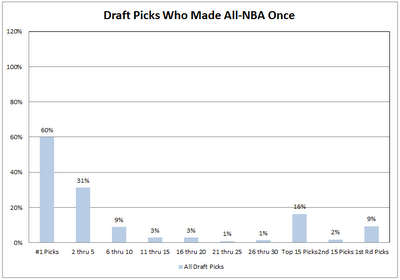Looking back at the NBA drafts from 1990 to 2009, there were 572 players drafted in the 1st round, and 54 of them made an All-NBA team at least once in their careers. As noted in the chart above, that's a 9% success rate overall. Now, the obvious point is that higher picks have been more successful over that time. But as GM's start to look over this year's potential picks, particularly from teams like Kentucky and UNC that boast multiple prospects, a very important question bears asking. Do GM's fall for players that play with other 1st round talents, even when history says it's a bad idea? To try and answer this, let's look at draft picks in three groups: draftees with no 1st round teammates, draftees with one 1st round teammate, and draftees with two or more 1st round teammates.
First, let's take a look at players who were the only players from their team drafted that year in the 1st round. This by far the largest of the three groups (471 players), and the success rates look largely similar to the generic group. There's honestly not that much interesting stuff in this group, other than remembering the #1 picks that haven't made an All-NBA team: Glenn Robinson, Joe Smith, Michael Olowokandi, Kenyon Martin, Kwame Brown, Andrea Bargnani, and Blake Griffin (for now).
Next up are draftees that had one teammate drafted in the 1st round in the same year. It's a smaller group (68 players), so not every number is meaningful (the only #1 pick in the group was Allen Iverson). It's probably worth noting that of the 8 All-NBA players drafted in this group, 5 of them were the 2nd guy drafted from a team (Latrell Sprewell after Robert Horry, Sam Cassell after Doug Edwards, Vince Carter after Antawn Jamison, Paul Pierce after Raef Lafrentz, Zach Randolph after Jason Richardson). And the 8th guy, Russell Westbrook, was drafted right before Kevin Love, but they'll both be All-NBA players after this season. So, really, out of all the 2 man classes drafted over this period, the All-NBA player was the 2nd guy picked 5 out of 7 times.
Finally, it's the members of the college super-teams, the guys who were drafted alongside at least 2 teammates in the 1st round. 33 players are in this group, and their respective college teams probably ring a bell:
Michigan '90, UNLV '91, Arkansas '92, Kentucky '96, Duke '99, North Carolina '05, Connecticut '06, Ohio State '07, Florida '07, North Carolina '09
While the overall number looks similar (9% hit rate versus all picks at 9%), the number seems deceptive. The three All-NBA players all came within the top 3 picks: Larry Johnson (#1 overall), Elton Brand (#1 overall), and Al Horford (#3 overall). The hit rate is literally nonexistent outside the top 5 picks. The other, hugely important observation: 3 of the 10 first picks off a team (Rumeal Robinson, Larry Johnson, Todd Day, Antoine Walker, Elton Brand, Marvin Williams, Rudy Gay, Greg Oden, Al Horford, Tyler Hansbrough) made an All-NBA team. That means none of the other 23 guys drafted from those super-teams (the 2nd and 3rd best guys on those college teams) hit that level of success.
What, if anything, should be drawn from all this? For me, it reinforces something we all probably know intuitively. College basketball can often involve teams and schedules of very different quality. That difference usually makes it very difficult to project a player's prospects, i.e. the small college star who plays against competition that probably won't make it to the NBA. But, that's most of college - there are over 300 D-1 teams, and 30 NBA teams. If a player's level of competition can make evaluators skeptical, history shows that a player's quality of teammates might require the same treatment.
Does this mean that the NBA draft world is looking at Anthony Davis and Harrison Barnes with rose-colored glasses? Based on the 20 drafts I looked at, no. Views of the best guy on these teams don't seem to get skewed. But should evaluators be careful with John Henson, Tyler Zeller, Kendall Marshall, Terrence Jones, Doron Lamb, and Marquis Teague? Yeah, I think they need to be very careful.
Oh, and maybe take another look at Jeremy Lamb, Tony Wroten, Mason Plumlee, Tyshawn Taylor, Fab Melo, John Jenkins, and Quincy Miller. As of right now, they're all the 2nd guy drafted from their respective college teams.





No comments:
Post a Comment